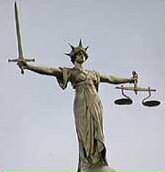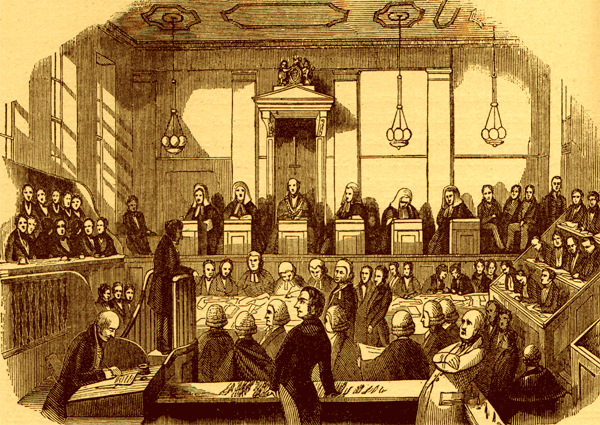



Tales from The Old Bailey
By Maureen Storey
This article was originally published in the April 2004 edition of Soul Search, the journal of The Sole Society
On the morning of 16 July 1794 Dinah Sole must have been quaking in her shoes.
On that day she gave evidence at the Old Bailey against her neighbour William Brightmore, who was charged with grand larceny. William was accused of stealing two hempen sacks (value 4s), a peck of wheat (value 1s 6d) and three pecks of flour (value 6s) from the mill of Charles Hamerton in Clapton, Middlesex.
In her testimony Dinah stated that on 26 June 1794 she met Brightmore and a needle-maker called Gamble near the River Lea about half a mile from her home. They said that they were going to Hamerton’s mill and would she like to go with them to have a look round. One floor of the mill had been sublet to a needle maker – the mill’s main granary was above the needle factory, the milling floor was below it, with grain chutes connecting the two – and Gamble had keys to the needle floor. Dinah said that she had never been in the mill before and so agreed to go with them.
She described how when the three of them entered the needle workshop Brightmore had commented on the amount of grain scattered around and suggested they should sweep it up for him to take home to feed his pigs. Dinah said that she then walked over to look out of the window and didn’t take much notice of what the two men were doing. After a few minutes she became aware of a whispered conversation and turned round to see Brightmore and Gamble filling sacks with corn from a small bin. They told her not to worry about what they were doing and once the sacks were full the three of them left the mill, Brightmore going first with the larger sack, then Dinah and finally Gamble with the smaller one.
They set off across the fields towards Clapton turnpike and the houses of Brightmore and Dinah. On the way they passed John Little, a miller at Hamerton’s who would later testify that he’d seen Brightmore carrying a sack away from the mill.
It isn’t clear from the evidence given at the trial how Brightmore came to be suspected of the theft. It’s reasonable to suppose that John Little recognized the sack Brightmore was carrying and reported it to the mill owners. In his testimony John Killick, the mill owner’s son-in-law, stated that some of the workers had reported seeing grain on the needle factory’s floor when they looked through chinks in the granary floorboards. On closer inspection it was found that small holes had been cut in the grain chutes and the granary floor, and bins placed beneath the holes to catch the grain. Both Killick and James Griffiths, the village constable, described how they found sacks of grain at Brightmore’s home. Both the sacks and the grain were identified by Killick as coming from the mill, the sacks by their markings and the grain because it was a super-dried grade that was sold only to the army.
William Brightmore denied all the charges against him. He claimed the sacks had been left at his house by a mill worker and that he’d bought the grain. He called five witnesses (unfortunately all unnamed in the transcript) who testified to his good character. He was found guilty of grand larceny and sentenced to seven years transportation.
Given the evidence presented at the trial there seems little doubt of Brightmore’s guilt, or of Gamble’s, who escaped prosecution only because he disappeared before he could be arrested, but what about Dinah? Did the court really believe that she knew nothing of what was going on while she ‘looked out of the window’ or that Gamble and Brightmore would have invited her along to witness their crime, or that she would have not been suspicious when they left the mill with sacks of grain? It seems much more likely that she was as guilty as Brightmore but escaped prosecution by agreeing to give evidence against him.
So who was Dinah Sole? A number of Soles (of various spellings) appear in the Old Bailey proceedings, witnesses, jurors, defendants and victims, but in most cases there isn’t enough information to be able to identify them. Dinah, however, is an exception. Because Dinah is a comparatively unusual name and because she says she lives with her husband, a bricklayer’s labourer, in Clapton, we can positively identify her as Dinah (nee Woodland), the wife of William Sole. At the time of the trial Dinah was about 25 years old and had a three-year-old daughter, Sarah. On a personal level I can only be grateful that Dinah was treated so leniently by the court because had she been transported like William Brightmore her son John wouldn’t have been born the following year – John was my 3 ´ great grandfather!
This story and thousands like it appear in the Proceedings of the Old Bailey which can now be found on-line at www.oldbaileyonline.org. The website so far includes all the trials between December 1714 and December 1799; those for 1674-1714 are due to be added in March 2004, and those for 1800-1834 in October 2004. It is hoped that the site will eventually include trials up to 1913. Next time you browse the Internet I recommend that you take a look. There’s a very easy-to-use search facility and if anyone can identify the Captain Richard Sowle who was tried for (and acquitted of) the murder of George Paschal in 1751, or the George Sole, public house keeper of Turnmill Street, Clerkenwell, whose 552 copper half-pennies were stolen by Mary Fitzgerald (who was sentenced to death) in 1795, please let me know.
